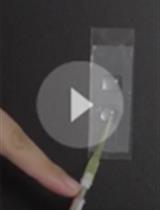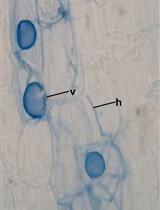- EN - English
- CN - 中文
Analysis of Chromosome Condensation/Decondensation During Mitosis by EdU Incorporation in Nigella damascena L. Seedling Roots
通过EdU掺入分析大马士革黑种草幼苗根中有丝分裂过程中染色体的凝集/解凝集
发布: 2018年02月05日第8卷第3期 DOI: 10.21769/BioProtoc.2726 浏览次数: 6829
评审: Amey RedkarSmita NairIsabelle Colas
Abstract
To investigate the chromosome dynamics during mitosis, it is convenient to mark the discrete chromosome foci and then analyze their spatial rearrangements during prophase condensation and telophase decondensation. To label the chromosome regions in plant chromosomes, we incorporated the synthetic nucleotide, 5-ethynyl-2’-deoxyuridine (EdU), which can be detected by click-chemistry, into chromatin during replication. Here, we described a protocol of a method based on the application of semi-thin sections of Nigella damascena L. roots embedded in LR White acrylic resin. The thickness of semi-thin (100-250 nm) sections is significantly lower than that of optical sections even if a confocal microscope was used. This approach may also be suitable for work with any tissue fragments or large cells (oocytes, cells with polytene chromosomes, etc.).
Keywords: Plant (植株)Background
Most data concerning chromosome organization have been acquired from studies of a small number of model organisms, the majority of which are mammals. In plants with large genomes, the chromosomes are significantly larger than the animal chromosomes that have been studied to date. To investigate the chromosome dynamics during mitosis, it is necessary to mark the discrete chromosome foci and then analyze their spatial rearrangements during prophase condensation and telophase decondensation. To label the chromosome regions, we incorporated the synthetic nucleotide, 5-ethynyl-2’-deoxyuridine (EdU) (Kuznetsova et al., 2017). Detection of EdU is based on a click-reaction, which is a copper catalyzed reaction between an azide and an alkyne. The EdU contains the alkyne which can react with the azide-containing detection reagent.
The most suitable distribution of labeled regions (i.e., separated labeled dots) was seen in cells which incorporated EdU during late S-phase. The brief pulse labeled all S-phase cells, and the initial appearance of EdU-labeled mitotic figures thus denoted the time needed for cells labeled in late S-phase to traverse into mitosis.
Root apical meristem does not allow for the acquisition of high-resolution images because of the out-of-focus fluorescence. Here, we described a protocol of a method based on the application of semi-thin (100-250 nm) sections of roots embedded in LR White acrylic resin. LR White is a polyhydroxy-aromatic acrylic resin with low toxicity and ultra-low viscosity. The polymerized resin is hydrophilic (sections freely permeable to aqueous solutions). The thickness of semi-thin sections is significantly lower than that of optical sections even if a confocal microscope was used. This approach may also be suitable for work with any tissue fragments or large cells (e.g., cells with polytene chromosomes).
Materials and Reagents
- 30 mm and 90 mm Petri dishes (Greiner Bio One International)
- Filter paper
- Single edge blades (Ted Pella, catalog number: 121-3 )
- 1.5 microtubes (SSIbio, catalog number: 1260-00 )
- Snap-fit Gelatin Capsules, Size 2 (Ted Pella, catalog number: 130-19 )
- Cover slips, No. 1 (Fisher Scientific, catalog number: 12-548A )
- Microscope slides (Thermo Fisher Scientific, Thermo ScientificTM, catalog number: AA00000112E00MNT10 )
- Parafilm
- Cotton wool
- Foil
- Safety gloves
- Nigella damascena L. seeds
- Click-iT EdU Alexa 555 Imaging Kit (Thermo Fisher Scientific, InvitrogenTM, catalog number: C10338 )
- Thymidine (Sigma-Aldrich, catalog number: T9250 )
- Phosphate buffered saline (PBS), pH 7.2 (10x) (Thermo Fisher Scientific, GibcoTM, catalog number: 70013016 )
- Ethanol
- 4’,6-Diamidino-2-phenylindole (DAPI) (Thermo Fisher Scientific, Thermo ScientificTM, catalog number: 62248 )
- Tris base
- Concentrated HCl
- Paraformaldehyde (Sigma-Aldrich, catalog number: P6148 )
- LR White embedding kit (Sigma-Aldrich, catalog number: 62662 )
Note: This product has been discontinued. - Formvar 1595E (Serva, catalog number: 21740 )
- 1,2-Dichloroethane anhydrous (Sigma-Aldrich, catalog number: 284505 )
- Mowiol 4-88 (Sigma-Aldrich, catalog number: 81381 )
- Glycerol (MP Biomedicals, catalog number: 04800687 )
- 1,4-Diazabicyclo-[2.2.2]-octane (Sigma-Aldrich, catalog number: D2522 )
Note: This product has been discontinued. - Deionized H2O
- 1 M Tris-HCl (pH 8.5) (see Recipe 1)
- Paraformaldehyde (see Recipe 2)
- LR White acrylic resin (see Recipe 3)
- Formvar coated cover slips (see Recipe 4)
- Mowion mounting medium (see Recipe 5)
Equipment
- Perfect Loop (Ted Pella, catalog number: 13064 )
- Orbital Shaker OS-20 (Biosan, model: OS-20 , catalog number: BS-010108-AAG)
- Laboratory incubator TC1/20 (SKTB, model: TC-1/20 , catalog number: 1003)
- Chemical fume hood
- Ultratome LKB III
- Fluorescent microscope Axiovision 200M (Carl Zeiss, model: Axiovision 200M ) equipped with the ORCAII-ERG2 camera (Hamamatsu).
Note: For deconvolution, AxioVision 3.1 software (Carl Zeiss) was used. - pH meter
- Magnetic stirrer with hot plate MSH-300 (Biosan, model: MSH-300, catalog number: BS-010302-OAA )
- Glass or diamond knife
- Micro-centrifuge MiniSpin (Eppendorf, model: MiniSpin® plus , catalog number: 5452000018)
Procedure
文章信息
版权信息
© 2018 The Authors; exclusive licensee Bio-protocol LLC.
如何引用
Sheval, E. V. (2018). Analysis of Chromosome Condensation/Decondensation During Mitosis by EdU Incorporation in Nigella damascena L. Seedling Roots. Bio-protocol 8(3): e2726. DOI: 10.21769/BioProtoc.2726.
分类
细胞生物学 > 细胞染色 > 核酸
植物科学 > 植物细胞生物学 > 细胞结构
植物科学 > 植物细胞生物学 > 细胞染色
您对这篇实验方法有问题吗?
在此处发布您的问题,我们将邀请本文作者来回答。同时,我们会将您的问题发布到Bio-protocol Exchange,以便寻求社区成员的帮助。
Share
Bluesky
X
Copy link














